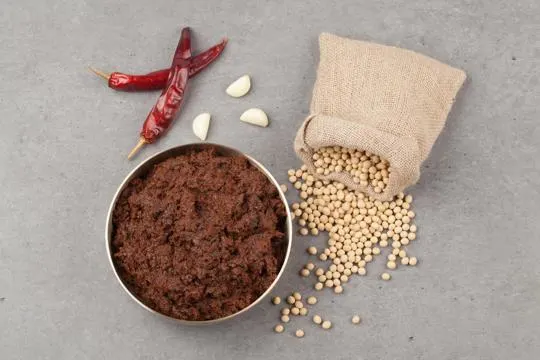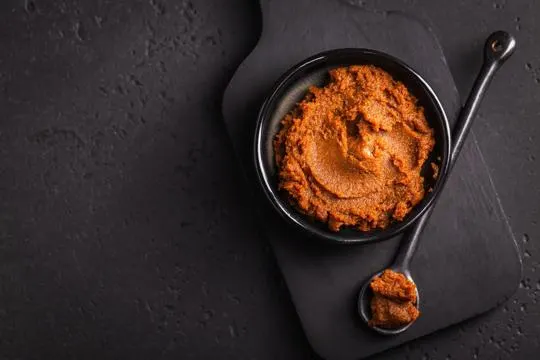Summary of key points
The main difference between fermented soybean paste and miso is their country of origin and specific ingredients. Fermented soybean paste, also known as doenjang, is a staple in Korean cuisine and is made with fermented soybeans, salt, and sometimes rice or barley.
Miso, on the other hand, originates from Japan and can be made with various grains like rice or barley, as well as soybeans and a culture called koji. Both are used in soups, marinades, and sauces, but miso often has a smoother texture and milder flavor compared to doenjang.
While they may have some differences in taste, both fermented soybean paste and miso provide deep umami flavors to dishes.
Fermented soybean paste and miso both sit in our fridges. They’re staples in many of our dishes. Bold truth: they’re not twins.
Each brings its own pizzazz to the kitchen. We’ve all been there, mixing them up, swearing our soup tasted off. Because, yes, they do differ! One’s from Korea, the other from Japan.
Texture? Different. Fermentation? Not the same. We learned this the hard way. Found ourselves scratching our heads over a bubbling pot.
Arm yourselves with knowledge, folks. With us, decode these kitchen mysteries.
What is Fermented Soybean Paste?

Doenjang, a traditional Korean condiment, offers a unique flavor.
It’s made with fermented soybeans, salt, and koji culture, so it has a savory aroma and umami taste.
Plus, it’s packed with protein, fiber, vitamins, and bacteria that help with digestion.
Miso, another fermented soybean paste, comes from Japan, but doenjang is Korean and has a stronger flavor due to different fermentation techniques.
You can use it to boost soups, stews, marinades, or as a dip.
Try doenjang for a delicious umami-packed treat.
What is Miso?

Miso: a traditional Japanese seasoning made from fermented soybeans.
It has a unique umami flavor, adding depth and complexity to dishes.
Made from soybeans combined with koji – a culture of steamed rice or barley and Aspergillus oryzae (a special mold).
Fermentation can take months to years, creating miso of different flavors and colors.
White (shiro), yellow (shinsu) and red (aka) miso.
White is mild and sweet due to shorter fermentation.
Yellow has a stronger flavor as it’s fermented longer.
Red has the strongest/saltiest taste – longest fermentation.
Other ingredients like salt, grains (rice/barley) added for flavor.
Miso is not only flavorful, but also healthy.
It has beneficial bacteria that support gut health and strengthen the immune system.
High in protein, vitamins, minerals like calcium, iron, potassium.
Uses: base for soups (miso soup), marinade for fish/meat, addition to dressings, sauces, glazes.
Miso: vital in Japanese cooking.
Enhances dishes, provides health benefits.
Suitable for traditional recipes and modern culinary creations.
Why not explore the world of miso? Elevate your cooking with this ancient Japanese treasure.
Differences Between Fermented Soybean Paste and Miso

Fermented soybean paste and miso may look similar, however, they are distinct.
Ingredients and Fermentation Process
Fermented soybean paste and miso may look alike.
But, they have their own unique distinctions.
It’s all down to the fermentation process and ingredients used.
Soybeans are soaked, cooked and mashed for soybean paste.
Salt is then added to create a brine.
Fermentation comes next with help from the Aspergillus oryzae mold.
This mold provides enzymes which break complex proteins into simpler forms.
This creates the unique flavors.
It usually takes months to years for the fermentation.
Miso has a slightly different process.
Cooked and mashed soybeans, plus koji rice.
Koji rice is steamed and inoculated with Aspergillus oryzae spores.
This is the starter culture for fermentation.
Salt is added and the mixture is left to ferment – for weeks to years, depending on desired flavor.
Ingredients differ between the two.
Soybean paste only has soybeans and salt.
Miso has koji rice and other grains like barley or wheat.
This gives variations in taste, aroma, color and texture.
To sum up, both fermented soybean paste and miso involve Aspergillus oryzae mold.
They start with cooking and mashing soybeans.
However, different ingredients give them different flavor profiles and culinary uses.
Knowing the differences helps us appreciate and use them across cultures.
Flavor Profiles and Regional Variations
The flavor profiles and regional variations of miso and fermented soybean paste are diverse.
Different cultures have their own special way of preparing these condiments, giving us a range of taste experiences.
In Japan, miso is known for its umami-rich flavor.
This comes from fermenting soybeans with salt and koji (a type of mold).
Longer fermentation equals more complex flavor.
Japan has different types of miso, like white miso from Kyoto or red miso from Nagoya.
Korean cuisine uses fermented soybean paste, called doenjang.
It has a unique taste – savory, sweet, salty, all of the above.
Rice or barley is added to soybeans then left to age for months.
China’s fermented soybean paste – doubanjiang or bean paste – varies depending on the beans used and whether chili peppers were added.
Flavors range from mild & earthy to spicy & tangy.
Sichuan province is well-known for its doubanjiang – often hot & spicy.
These variations offer a whole new world of flavors.
Cooks can explore different dishes and enjoy the complexity of fermented soybean pastes.
From Japan’s miso to Korea’s doenjang to China’s doubanjiang – these condiments bring exciting new culinary experiences.
Culinary Uses and Applications
Fermented soybean paste and miso both have uses in Asian cuisine.
They bring flavor and texture to soups, marinades, and sauces.
Doenjang, as it’s called in Korean cuisine, is a type of paste made with fermented soybeans and salt.
It has a rich umami flavor.
It is often used in stews, side dishes, and bean soup.
Miso is a Japanese condiment made from fermented soybeans, koji, and salt.
Its color and flavor vary.
It is used in soups, dressings, glazes, and marinades.
Though both have similar culinary uses, they are distinctive in their own way.
Knowing their differences helps cooks explore Asian cuisine and use these flavorful condiments.
Similarities Between Fermented Soybean Paste and Miso

Fermented soybean paste and miso have a lot in common.
They both come from Asia, mostly Japan and Korea.
They both have an umami flavor and lots of nutrition.
To make them, soybeans are fermented with salt and koji culture.
This fermentation process adds flavor.
Both condiments can be used to make soups, marinades and sauces.
They add richness and complexity.
Fermented soybean paste is mainly used in Korean cuisine.
Miso is more popular in Japanese cooking.
Comparing Nutritional Value and Health Benefits
Fermented soybean paste and miso are both popular ingredients used in different cuisines.
But, what sets them apart in terms of nutrition and health benefits? Let’s discover the differences.
Both have a wealth of proteins, vitamins, and minerals.
However, fermented soybean paste has a higher amount of protein and fiber than miso.
On the other hand, miso is lower in calories and fat content.
Fermented soybean paste is known for its probiotic properties.
It has beneficial bacteria that can aid digestion and boost immunity.
Plus, it may help to lower cholesterol and reduce the risk of certain cancers.
Miso is full of antioxidants.
These compounds protect the body from damage caused by free radicals.
Furthermore, studies suggest that it can improve cardiovascular health and reduce the risk of chronic diseases like hypertension and heart disease.
The flavors of the two vary significantly.
Fermented soybean paste has an umami flavor, making it the perfect addition to soups and stews.
Miso has a milder and sweeter taste that can complement a variety of dishes.
Pairing and Cooking Recommendations for Fermented Soybean Paste and Miso
Fermented soybean paste and miso have varying cooking and pairing options, creating a wealth of possibilities.
This dynamic duo adds flavor to Korean stews and Japanese miso soup.
The umami taste of the paste is great for marinades on meat and vegetables.
Miso brings a savory flavor to dressings and glazes.
Fermented soybean paste is perfect with beef or pork.
It adds to dishes like doenjang jjigae or Korean lettuce wraps with grilled meat marinated in soybean paste.
Miso has a lighter, sweeter taste and goes well with delicate proteins like fish or tofu.
White miso sauce on salmon and marinated tofu are great.
These ingredients can also be used outside of Asian cuisine.
Try adding a spoonful to soups, stews, or even pasta sauces.
The umami kick will add something special.
Fermented soybean paste and miso can bring unique elements to recipes.
Use these ingredients to expand your culinary experience.
Conclusion
As we have explored, there are a few key differences between fermented soybean paste and miso.
Miso is a versatile Japanese condiment that can be used in various dishes, while fermented soybean paste is often used as an ingredient for marinades and sauces.
Likewise, fermented soybean paste has a thicker consistency with a distinct pungent aroma, while miso is much smoother and sweeter in taste.
All in all, both miso and fermented soybean paste have been used for hundreds of years to enhance the flavors of food – although they have different culinary usages, it’s interesting to see how these two traditional ingredients are similar at the same time.
Thus your choice depends on the type of dish you wish to create.
Hopefully this post has shed some light on the differences between fermented soybean paste and miso.

Leave a comment